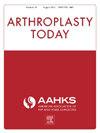Defining “Paradoxical Instability” and Other Indications for Aseptic Single-Component Polyethylene Revision: A Cohort Study Including Mid-flexion Instability and Limited Arc of Motion
IF 2.1
Q3 ORTHOPEDICS
引用次数: 0
Abstract
Background
Single-component polyethylene revision (SCPR) is a less invasive approach for addressing polyethylene wear in total knee arthroplasty by replacing only the tibial polyethylene component. While traditionally used for aseptic ligamentous mid-flexion instability and limited arc of motion, this study introduces paradoxical instability as a third indication, characterized by ligamentous laxity with knee effusion causing mid-flexion instability and secondary flexion contracture.
Methods
A retrospective study analyzed 58 consecutive SCPR patients treated by a single fellowship-trained surgeon between 2012 and 2024, with a minimum 2-year follow-up. The cohort included 20 men (34%) and 38 women (66%), with a mean age of 70.2 years and average follow-up of 2.83 years. Patients were categorized into 3 groups: mid-flexion instability (n = 43), limited arc of motion (n = 9), and paradoxical instability (n = 6). Outcomes were assessed using clinical examinations and Knee Society Score 2011 and UCLA activity scores.
Results
Clinical success rates defined as good to excellent clinical outcomes were 88.3% (38 of 43) for mid-flexion instability, 88.8% (8 of 9) for limited arc of motion, and 100% (6 of 6) for paradoxical instability patients. No readmissions or reoperations occurred within 90 days postsurgery. The mean hospital stay was 0.87 days.
Conclusions
SCPR demonstrated effectiveness in treating all 3 indications, with particularly promising results for paradoxical instability cases. This study establishes paradoxical instability as a distinct clinical entity characterized by knee imbalance, mid-flexion instability, recurrent effusions, and limited motion arc. This limited motion arc is paradoxically treated with an increase of polyethylene thickness. The findings support SCPR as a viable treatment option for carefully selected patients with these conditions.
定义无菌单组分聚乙烯改良术的“矛盾不稳定性”和其他适应症:包括中屈曲不稳定性和有限运动弧度的队列研究
背景:单组件聚乙烯翻修术(SCPR)是一种侵入性较小的方法,通过仅更换胫骨聚乙烯组件来解决全膝关节置换术中聚乙烯磨损的问题。虽然传统上用于无菌韧带中屈曲不稳定和有限的运动弧度,但本研究引入了矛盾不稳定作为第三个适应症,其特征是韧带松弛伴膝关节积液导致中屈曲不稳定和继发性屈曲挛缩。方法一项回顾性研究分析了2012年至2024年间由一名研究员培训的外科医生治疗的58例连续SCPR患者,随访时间至少为2年。该队列包括20名男性(34%)和38名女性(66%),平均年龄70.2岁,平均随访时间2.83年。患者分为3组:中屈曲不稳定(n = 43),有限运动弧度(n = 9)和矛盾不稳定(n = 6)。结果评估采用临床检查和膝关节社会评分2011和UCLA活动评分。结果中屈曲不稳定患者的临床成功率为88.3%(38 / 43),有限运动弧度患者为88.8%(8 / 9),矛盾不稳定患者为100%(6 / 6)。术后90天内无再入院或再手术。平均住院时间0.87天。结论scpr对所有3种适应症均有效,尤其对矛盾不稳定病例疗效显著。本研究确立了矛盾不稳定作为一个独特的临床实体,其特征是膝关节不平衡、中屈曲不稳定、反复积液和运动弧度受限。这种有限的运动弧被矛盾地用聚乙烯厚度的增加来处理。研究结果支持SCPR作为一种可行的治疗选择,为精心挑选的患者这些条件。
本文章由计算机程序翻译,如有差异,请以英文原文为准。
求助全文
约1分钟内获得全文
求助全文
来源期刊

Arthroplasty Today
Medicine-Surgery
CiteScore
2.90
自引率
0.00%
发文量
258
审稿时长
40 weeks
期刊介绍:
Arthroplasty Today is a companion journal to the Journal of Arthroplasty. The journal Arthroplasty Today brings together the clinical and scientific foundations for joint replacement of the hip and knee in an open-access, online format. Arthroplasty Today solicits manuscripts of the highest quality from all areas of scientific endeavor that relate to joint replacement or the treatment of its complications, including those dealing with patient outcomes, economic and policy issues, prosthetic design, biomechanics, biomaterials, and biologic response to arthroplasty. The journal focuses on case reports. It is the purpose of Arthroplasty Today to present material to practicing orthopaedic surgeons that will keep them abreast of developments in the field, prove useful in the care of patients, and aid in understanding the scientific foundation of this subspecialty area of joint replacement. The international members of the Editorial Board provide a worldwide perspective for the journal''s area of interest. Their participation ensures that each issue of Arthroplasty Today provides the reader with timely, peer-reviewed articles of the highest quality.
 求助内容:
求助内容: 应助结果提醒方式:
应助结果提醒方式:


